 Research Article
Research Article
The Memory of The Human Body, The Prevention and Treatment of Sport Injuries and Physical Exercise for Health During Artistic Gymnastic Training
Cauli Alessandra*
Dipartimento Di Scienze Matematiche, Politecnico Di Torino, Corso Duca Degli Abruzzi 24, Torino, Italy
Cauli Alessandra, Dipartimento Di Scienze Matematiche, Politecnico Di Torino, Corso Duca Degli Abruzzi 24, Torino, Italy
Received Date:April 24, 2024; Published Date:May 10, 2024
Objective: We deal with artistic gymnastic training, which it requires physical well-being, encouraging and improving self-efficacy during
force rapidity cycles, preventing this sport injuries, for a population of individuals twenty-five years old and over old. In what concern outstanding
the cycle trading, in the aim of personal, individual and team gaining of physical performances, we will analyze how the memory of the human
body influences posture evaluation, whilst personalized treatment cares, physicians must operate despite several types of incidents onto stressed
conditions in respect to wide attention, concentration and liability, normal sportive activities, and following standard programs of artistic gymnastic
training, considering relevant and relax sessions for psychological behaviors. In all physical sessions before and after exercising it is fundamental for
athletes to guide them in all training, mainly to behavior from start to end empowerment results.
Methods: 144 registered athletes volunteered to participate in this study, ranking their performances by apparatus, and with ranges from 0 to
24 scores. Then, the study involves 144 athletes exhibiting one evolution of artistic gymnastic exercise, in high performances and in strong stressed
condition execution. Then, the measure of force rapidity cycles, in these cases, is measured by computing the difference between the highest score
attributed to the exhibiting proof, and the real obtained score, if it is in the higher ranges, following collected data in the Kaggle dataset. Finally, we
classify the athletes of this competition in two classes based on their scored range.
Results: Emphasis will be placed on the use and calibration of equipment as well as adaptation of equipment to different research settings.
Conclusions: Social actions and behavioral patterns as influenced by the communication process in teams; experiential approaches to techniques
of interpersonal and small group relationships and leadership on big sport teams; the constantly evolving communication media as instruments of
behavioral change.
Keywords:Physical Exercise; Sport Injuries; Gymnastic Training; Human Body; Exercise Physiology; COVID-19
Introduction and Purpose
Human physiological responses, from the cellular level to organ system level, to both acute and chronic exercise will be studied in detail with an emphasis on integrative physiological responses to exercise. This sport emphasizes a complex regulatory systems approach to the changes and adaptations that occur with exercise. Specifically, how the regulatory systems dictate these changes. This case study will aid in the understanding of both theoretical and integrative concepts in the area of exercise physiology [1]. The paper will provide a solid foundation that is needed to review and understand complex research in exercise physiology. The study of the memory of the human body during artistic gymnastic training is an application and methods of caring for and preventing athletic injuries through strapping, padding, conditioning, etc.; practical application of first aid and a basic introduction to treatment and rehabilitation of common athletic injuries.
Surely, interesting is the purpose to investigate the effects of various sports interventions on adolescents’ physical fitness, see for example [2], by means of which we consider the fact the age of sporting people is not influencing too much how memory of the human body searches life equilibrium, instead of it, it is fundamental how athletes’ forms training programs and postures. Making a flashback, mandatory is reading [3], while children and young adults were originally thought to escape severity and lingering symptoms of COVID-19, we know that Post Acute Sars COVID-19 affected many of them significantly, including athletes. Statistical analysis reveals a significant negative relationship between mean sprint time and PVO2, indeed, subjects with higher aerobic activity or PVO2 would also have low mean sprint times, as in [4,5]. Postural deviations have been linked to a series of different kinds of pain and dysfunction, in [6], while in the review [7], has explained how evaluate the use of photogrammetry and identify the mathematical procedures applied when evaluating spinal posture. In these reasons, future athletes and athletes will encourage selfimprovement through posture evaluation, biomechanic analysis of exercises performed and through participation in varied exercise forms. Students will develop personalized programs for the strength, suppleness and stamina exercises calculated to improve possible deficiencies in posture or movement to optimize enjoyment of living. Indeed, there are different methods for assessing body posture used in physiotherapeutic research. In the review [8], they are found ten assessment methods: Postural Assessment Software (PAS), digital photography, photogrammetry, photography, Kendall et.al. method, Kendall et.al. method with photography, New York Postural Assessment method (NYPAM), biophotogrammetry, evaluation form, and posturograma. Among others, the most used method is PAS (15 papers), followed by Kendall et.al. method with photography (six papers). Encouraging training programs of athletes Introduces the lifter to the sport of weightlifting which consists of the two lifts, used in Olympic competition. It includes the complete breakdown of the two lifts, the assistive lifts necessary to learn the parts of the two lifts, and the proper training sequence. The students will also be introduced to training cycles, proper diet, and the use of assistive equipment. Indeed, in [9], some recommendations on the development of speed and strength qualities of the athlete and the process are given in these senses. In contrast, the conducted data analysis in [10], shows that a five-week periodized carbohydrate diet does not improve maximal lactate steady-state exercise capacity and the substrate oxidation in well-trained athletes. In fact, a prolonged exercise of 1-6 hours in duration, implies the extensive review of the energy metabolism, cardiovascular and pulmonary function, the endocrine response, the nutritional need, the training effect, and biochemical response to the exercise. In our study, we focus on twenty-five years old athletes for considering the positive and negative aspects of vigorous exercise and/or sport activity throughout the aging process, included will be inquiry into the opportunities for activity among adults over the age of thirty, through the active career years, and beyond.
Methods
After training programs, it is strongly recommended the use of sport films to examine relationships of power in society and the way in which those relationships are contested and often reinforced. Particular attention will be paid to cultural tensions and negotiations around issues related to race, gender, class, and sexuality. Utilizing films after training, with accompanying readings, to understand the institution of sport in American culture, as well to understand how sport is setting where issues of race, class, gender, religion, ability/disability, and sexuality are contested and reinforced. Indeed, biomechanical principles in the prescription of musculoskeletal rehabilitation exercises by means of passive, active and resistive range of motion, manual muscle testing, and exercises for strength, stamina and suppleness for every part of the body.
We collected data from [11], where we described statistic variables, immediately. Kaggle data are composed of 144 examples of 8 statistic variables: the name of athlete; overall rank [1-24]; nationality; apparatus; difference score [3.7-7.2], in what concern the exhibition and the expected maximum value of one performance; execution score [6.07-9.4]; total score [10.6-15.7]; rank by apparatus [1-24]. They are featuring basically the performance of 24 Gymnastic Olympic athletes by means of Apparatus. We want to apply a classification machine learning method to prioritize if in the next game, the athlete would ameliorate its overall rank. This method not only will give the best classified athletes in the Olympic Games of 2017, but it will provide a list of athletes who could improve their performance in the next competition.
Results
We resume here the fact that we want to realize some probability calculations, as doing exercising with them. In fact, the dataset is not interesting for us in terms of forecasting or inferential studies, so we conduct some descriptive considerations as results. In fact, the following figure represents the 2017 Olympic Results for Execution scores and Ranks (Figure 1).
Figure 1:
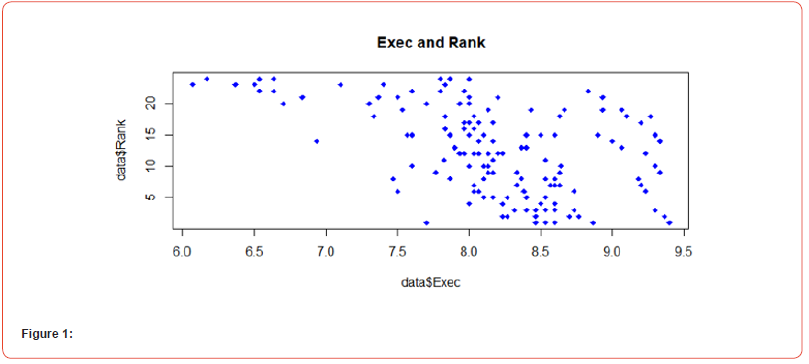
Then, the probability to obtain a rank greater than 21 (max. value of 24) of execution by one Apparatus per Athletes is as follows, referred data od 2017. Initially, this Olympic competition results and ranks are as initial scores per apparatus; data had ordered by Overall Rank decreasing (Table 1).
Table 1:

The orange column highlights the probability of scoring a very high rank, more than 21, that is 0.1667 which corresponds to 16.67% of these 24 Olympic athletes. The analogous of this large table is the following bar plot where are listed the performance per execution and rank (Figure 2, Table 2).
Table 2:
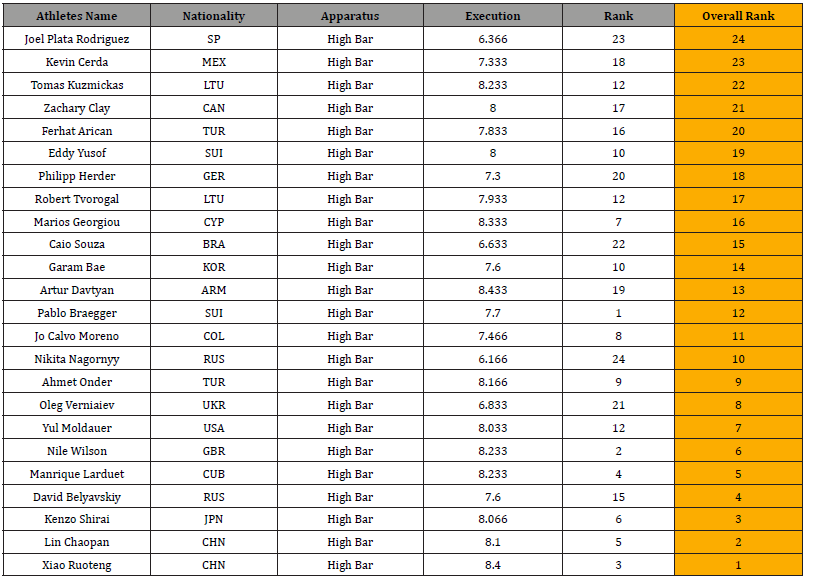
Figure 2:We now focus the analysis onto the specialized game I prefer that it is High Bars:
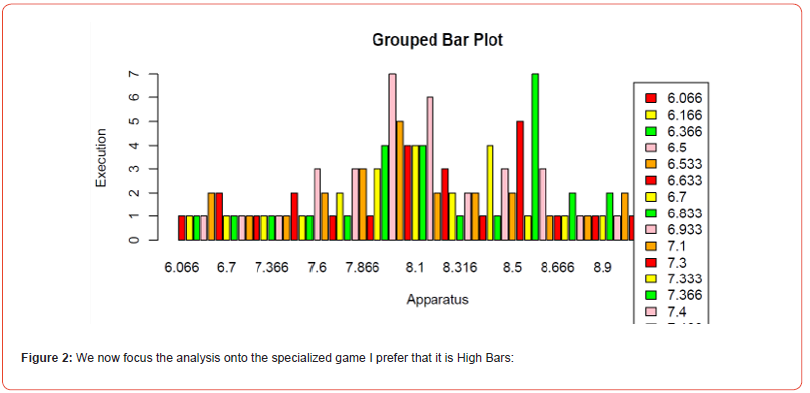
24 athletes are losing against others besides this discipline of artistic gymnastics and the frequent probability to achieve a very high overall rank is 4/24=0.1667 again that it is the 16.67% of athletes for this specialty too. Then, let us consider a third specialty artistic gymnastic sport: Rings (Table 3).
In accordance with the histograms onto data, alongside this analysis onto Rings, only 4/24 athletes scored a very high rank. Now, we show in fact that the relative percentage to obtain a very high rank is proportional to apparatus and it is independent from its choice, certain the fact that initial data are considered to be normal as an empirical distribution as sampled data. Using more descriptive statistic we can say the mean value of the Rank per Apparatus is contained in the vector R= (10.5, 13, 12.5, 12.5, 14.5, 13), considering the apparatus in the order: Floor, Pommel Horse, Rings, Vault, Pbars, High Bars (Figure 3).
Figure 3:R Studio, analysis of initial distribution of data.
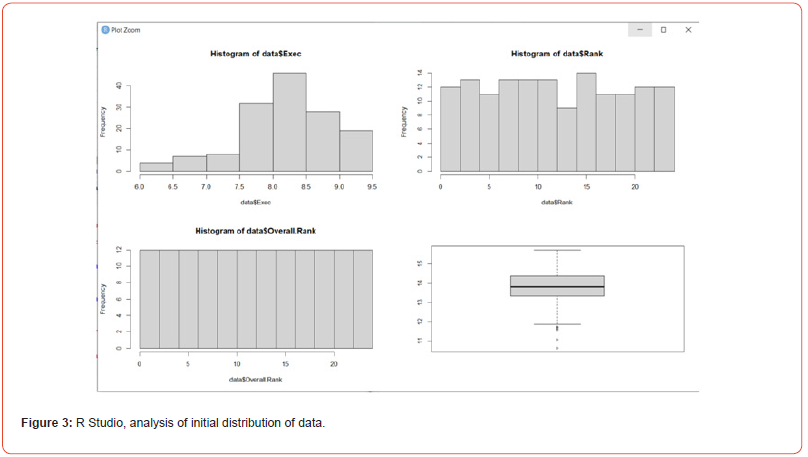
Table 3:
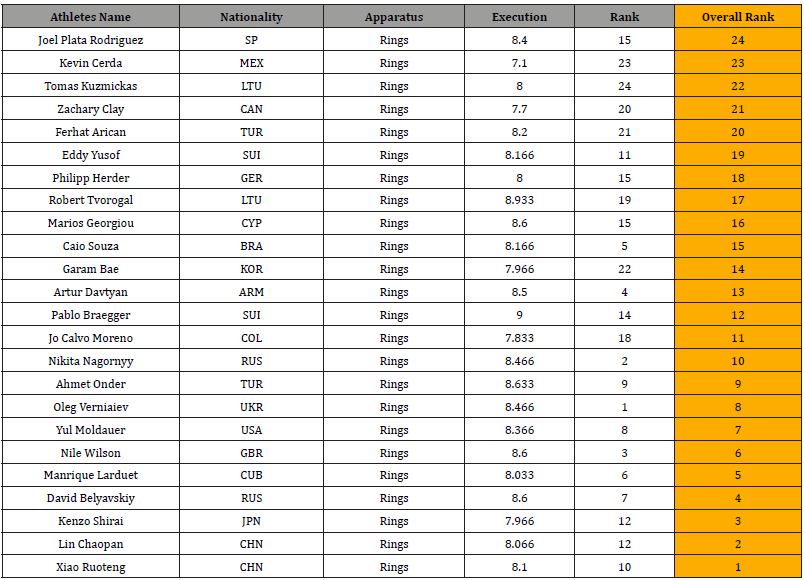
Discussion
The hip flexion Range of Motion, Countermovement jump, free hands countermovement jump and, Peak Torque of concentric knee extensors and concentric/eccentric knee flexors at 600/sec and 1800/sec, for both limbs, were measured in [1] using an isokinetic dynamometer before and immediately after exercise intervention. The registered deficits in performance were due to a combined program involving muscular activation and neuromuscular control with or without instruments; pre-warm-up actions on performance markers and injury prevention not very well did.
It is important for clinicians to understand the pathological blood lactate concentration [La-]b response as well as the normal [La-]b response to exertion, as analyzed in [5]. Psychologically, the athletes study the motor and cognitive characteristics of individuals involved in learning and controlling motion skills and the conditions that can influence that learning and control, expressing the sport competitions. Indeed, the application of research findings as they apply to psychological performance factors in sport, physical education and exercise settings, such as motivation/adherence, stress management, personality and psychological skills training is then motivating. On one hand, for this sport, a questionnaire was written to survey the role of motivation in artistic gymnastics by results in [12]. On the other hand, artistic gymnastics coaches learn about their gymnasts’ motivation and know how to sprint more on their expression and games in sports, see for example [13]. By this point of view, students will be introduced to coaching theory as it relates to developing leadership skills to work with athletes, and teams in the context of organized sport. Topics will include motivation, self-esteem, leadership, communication, competition and cooperation, team management, and optimal performance skills (goal setting, concentration, composure, recovery from mistakes/loss, consistency, and stress management). Besides this, it educates future coaches on the moral and ethical dilemmas typically encountered in competitive athletics. Students will also develop strategies to address various forms of exclusion and inequity in sports and athletics.
Conclusion
The research topic we accomplished here is designed to prepare students to teach, design, and implement strength/conditioning for various fitness/athletic populations. Included are skill techniques, skill analysis, class/group organization, equipment analysis, muscular fitness related to athletics, fitness, rehabilitation, and other factors related to effective teaching of muscular fitness in high school, college, private, public and corporate settings. Emphasis is on kinesiology/biomechanics principles, human anatomy, and physiological adaptations to the various strength/conditioning for fitness/athletic training covered in this research article. Indeed, from the educational sport medicine point of view, it is important to examine one recent research on the human body and to choose a specialization in pre-physical therapy or pre-occupational therapy. This is the way to take familiarity with equipment that monitors physical performance.
Acknowledgement
None.
Conflict of interest
No Conflict of Interest.
References
- AE Kyranoudis, I Ispyrlidis, A Chatzinikolaou, D Gargaliamos, Y Michalidis, et al. (2021) Effect of the pre-warm-up exercise program on muscle performance. Journal of Physical Education and Sport 21(1): 396-405.
- Y Li, APK Kwok (2021) The effects of after-School Training of Different sports events on the physical fitness of Adolescents and its comparative analysis. Advances in Physical Education 11(03): 321-330.
- JP Niemeier, JA Trapani, AM Cook, JD Avkerson (2023) Is it time for a SCovidAtest” for pediatric and young adult athletes affected by Post Avute SARS COVID (PASC)?. Academic Journal of Sport Science & Medicine 1(3): 1-2.
- M Miltenberger, G Zipp, V Lombardi, R Parasher, S Davis (2024) The correlation of repeat sprint measures to Pvo2 in recreationally Active College Age Males. Academic Journal of Sport Science & Medicine 1(5): 1-6.
- Matthew L Goodwin, James E Harris, Andrés Hernández, L Bruce Gladden (2007) Blood Lactate Measurements and Analysis during Exercise: A Guide for Clinicians. Journal of Diabetes Science and Technology 1(4): 558-569.
- JL Piementel do Rosario (2014) Biomechanical assessment of human posture: A literature review. Journal of Bodywork and Movement Therapies 18(3): 368-373.
- TS Furlanetto, JA Sedrez, CT Candotti, JF Loss (2016) Photogrammetry as a tool for the postural evaluation of the spine: A systematic review. World J Orthop 7(2): 136-148.
- XB Petermann, E Meereis (2020) Postural body: a systematic review about assessment methods. Manual Therapy Posturology & Rehabilitation Journal.
- Каримов Фахриддин (2022) Methodology of weightlifting with athletes. Web of Scientist; international scientific research journal 3(4).
- G Prieto, J Diaz-Lara, DJ Bishop, J Fernández-Sáez, J Abián-Vicén, et al. (2024) A Five-Week Periodized Carbohydrate Diet Does Not Improve Maximal Lactate Steady-State Exercise Capacity and Substrate Oxidation in Well-Trained Cyclists compared to a High-Carbohydrate Diet. Nutrients 16(2): 318.
- Dataset: Gymnastics World Championships 2017. kaggle.com.
- I Munkácsi, Z Kalmár, P Hamar, Z Katona, Henriette Dancs (2012) Role of motivation in artistic gymnastics by results of a questionnaire based international survey. Journal of Human Sport and Exercise 7(1Proc).
- M Nunomura, Y Okade, P Carrara (2012) How much artistic gymnastics coaches know about their gymnasts' motivation. Science of Gymnastics Journal 4(2): 27-37.
-
Cauli Alessandra*. The Memory of The Human Body, The Prevention and Treatment of Sport Injuries and Physical Exercise for Health During Artistic Gymnastic Training. Aca J Spo Sci & Med. 2(1): 2024. AJSSM.MS.ID.000528.
-
Physical Exercise, Sport Injuries, Gymnastic Training, Human Body, Exercise Physiology, COVID-19
-

This work is licensed under a Creative Commons Attribution-NonCommercial 4.0 International License.
- Abstract
- Introduction
- Materials and Methods
- The Basic Tools of Scientific Inquiry
- Literature Review
- Theoretical Framework
- Research Design
- Findings and Discussion
- Conclusion and Recommendations
- Based on the findings, the following recommendations are considered:
- Declaration Statements
- Funding
- Data Availability Statement (DAS)
- Compliance with Ethical Standards
- Acknowledgement
- Conflict of Interest
- References






